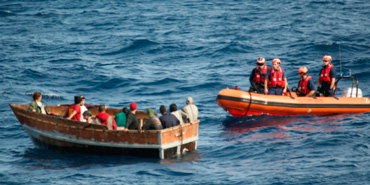Cuban Adjustment Act: It’s up to the other side
Carlos Pereyra (Progreso Weekly)

HAVANA TIMES — The final scene of the Cuban film “Juan of the Dead” shows the good guys taking to the sea in an antique car adapted for sailing by means of inflated bags and other flotation devices. For that adventure, they were better prepared than the hundreds of Cubans who have tried to cross the Straits of Florida in crafts resembling paper boats.
If the movie heroes in their car-boat and/or the many who have risked their lives on makeshift rafts stepped (or step) on U.S. territory, “no problem.” The Cuban Adjustment Act protected (and protects) them if their feet are dry. If they’re wet, they get a free return-trip ticket to Cuba on a US Coast Guard boat.
The topic of the illegal immigration of Cubans into the US goes back in time and my compatriots are sheltered by the US law that grants them permanent residence one year after arrival, along with other special benefits.
Only for Cubans
Other immigrants are not entitled to the benefits because our people are harassed for their political opinions, never mind that the basic motive for their travel has been for years (and is today) the economic factor.
According to Washington, everyone who flees the island is not an émigré but someone persecuted for his ideas, etc., because the system as a whole doesn’t work.
Allow me to ask: does Mexico’s political system work? Or the political system of other countries that feed illegal immigration in an impressive volume? Do the Castro brothers rule those countries too?
The point is that Washington, with its opportunities made public for years and codified into law, clearly encouraged illegal departures and human trafficking. What Cuba needs to do is improve the economic conditions on its own soil; the same applies to Mexico and other countries afflicted by large scale emigration.
Route 80
“I have tried to leave in several ways,” says Pepe, 51, who works as an independent plumber and electrician.
In 1996, he and others tried to leave from a spot west of Baracoa Beach in western Cuba, “but there were too many of us for a boat that could carry only three or four,” he said. They drew straws to see who’d remain behind “and I came up short.”
In 2002, Pepe showed up at the US Interests Section in Havana because he had (“and still has”) a cousin in Miami. “They turned me down,” he said. The US consul denied him a visa and he believes that it was because the diplomat thought Pepe would overstay his visa and become an émigré.
“They screwed me, but they were right. I was planning to stay there,” he said.
But Pepe saw a light. Some friends told him that there was a “Route 80″ (an allusion to the speed boats used by smugglers, which can travel at speeds up to 80 knots). A safe and speedy trip on a two-engine speedboat. He would reach Miami in six hours, at most.
Route 80 boats made (or make, I’m not sure) regular trips between the Florida Keys and Cojímar because apparently “they knew the schedules of the US and Cuban coast guards — and I got enthused,” Pepe said.
The boatmen who work for “Route 80? follow the same pattern of the infiltration boats into Cuba, back in the 1960s. The traffic lanes are similar to the ones used by drug traffickers. Living in luxury in the Bahamas is “El Cojo” (the Gimp), a boatman bolder than Columbus who set the maritime routes for infiltration into Cuban waters.
But let us continue with Pepe, who says that the offer of that way out reminded him of the saying that goes “joy is brief in the poor man’s home.”
“Someone in the US had to pay [the smuggler] some 5 thousand dollars, and my cousin — who worked two jobs and had to look after her two children — couldn’t do it.”
The other alternative was being a last-minute replacement for a no-show, “but I had to pay $2,000 to my contact here and the rest to the boatman as soon as I boarded the speed boat.”
He takes a breath and says: “How the hell could I come up with so much money? Nyah, I gave up. Today I’m eking out a living here and hoping to see if this improves because if I get [to Florida] now, at my age, I won’t find a job.”
Now what?
The future of the Cuban Adjustment Act is up to the authorities in Washington, not in Cuba. However, the two countries must agree — systematically, not on an ad-hoc basis — to persecute human trafficking.
The task of ordinary Cubans here is to reform the economy, remove the barriers that prevent us from producing more and better, and to expand the opportunities for individual initiatives and second- and third-tier cooperatives, so we may earn more money, because today’s wages are not enough.
And we should participate more actively and decisively, like the citizens we are.

Thanks for an objective , clear view of the balseros, their predicament ( poverty) and the call for democratic participation from the bottom: the solution to Cuba’s problems that came at the end.
That said, neither the GOUSA whose imperialist free-enterprise capitalism- enforcing foreign policy is determined by the oligarchy, nor the current Leninist leadership……… IF they remain Leninist when and if the embargo is lifted……… , want democracy .